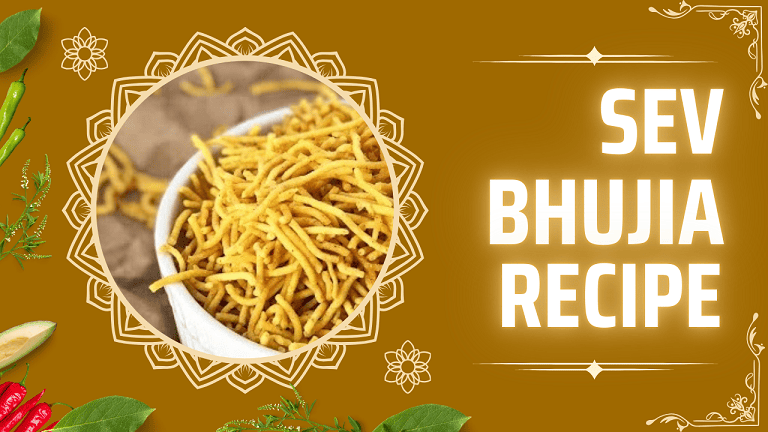Sev Bhujia Recipe
Sev Bhujia is a beloved Indian snack, especially popular in the northern and western parts of the country. Made from gram flour (besan) and a blend of aromatic spices, sev bhujia is a versatile dish.
It’s often used as a topping for chaats, added to poha, or simply enjoyed as a crunchy snack with tea. While it’s typically deep-fried, you can make modifications to ensure it remains a wholesome, healthy option.
Sev Bhujia has roots in the Indian culinary tradition, with its origins tracing back to the state of Rajasthan, where it became a staple snack due to its long shelf life and ease of preparation.
Over time, its popularity spread across the country, and many regions have developed their own variations of the recipe. Today, sev bhujia is made in households during festivals, served to guests, and included in gifting packages during celebrations.
This recipe focuses on creating a nutritious version of sev bhujia, using fresh, locally sourced ingredients that are readily available in India. The incorporation of spices and herbs not only enhances the flavor but also boosts its nutritional profile. We’ll also suggest variations and substitutions for different dietary preferences.
Health Benefits of Sev Bhujia
Rich in Protein: Made from besan (chickpea flour), sev bhujia is a good source of plant-based protein, which helps in muscle repair and overall body maintenance.
Good for Digestion: The use of spices like asafoetida, cumin, and ajwain aids in digestion and helps prevent bloating or indigestion.
Energy Boosting: Gram flour is rich in carbohydrates, making sev bhujia an excellent snack for a quick energy boost.
Ingredients
This recipe yields approximately 4 cups of sev bhujia:
- Besan (Gram Flour): 2 cups
- Rice flour: 1/4 cup (for added crispiness)
- Ajwain (Carom seeds): 1/2 teaspoon (great for digestion)
- Turmeric powder: 1/2 teaspoon (for color and anti-inflammatory properties)
- Red chili powder: 1 teaspoon (adjust to taste)
- Asafoetida (Hing): 1/4 teaspoon (to enhance digestion and flavor)
- Salt: 1 teaspoon (or to taste)
- Ghee or butter: 2 tablespoons (adds richness and flavor)
- Water: As needed to form a dough
- Oil: For deep frying (use groundnut or sunflower oil for a neutral flavor)
Optional Add-ons for Variations
- Spinach puree: 1/4 cup (for a healthier, vibrant green sev)
- Garlic powder: 1 teaspoon (for a garlic-flavored sev)
- Cumin powder: 1/2 teaspoon (adds an earthy flavor)
Step-by-Step Instructions
Step 1: Prepare the Dough
Sift the flours: In a large mixing bowl, sift the gram flour and rice flour. Sifting helps remove lumps and ensures an even texture in the dough, resulting in a smooth, uniform sev.
Add dry ingredients: Mix in ajwain, turmeric, red chili powder, asafoetida, and salt. These spices not only enhance the flavor of the sev but also add nutritional benefits. Ajwain and asafoetida aid digestion, while turmeric adds anti-inflammatory properties.
Incorporate ghee or butter: Add the ghee or softened butter to the flour mixture. Use your fingers to rub the fat into the flour until it forms a crumbly texture. This step is crucial for creating the desired light, crispy texture in the sev bhujia.
Form the dough: Gradually add water, a little at a time, and knead the mixture into a soft, smooth dough. The dough should not be too tight or too sticky, as this will affect the ease of pressing the sev and its texture after frying. Aim for a consistency where the dough holds its shape but is pliable enough to pass through the sev press.
Step 2: Shaping the Sev
Prepare the sev press: Use a sev maker or a murukku press fitted with a fine-holed plate to create thin, delicate strands of sev. Grease the inside of the press with a little oil to prevent the dough from sticking.
Fill the press: Break off a portion of the dough and place it inside the sev maker.
Shape the sev: On a clean surface or directly over the hot oil, press the dough into thin, noodle-like strands. Make circular motions as you press, ensuring the sev strands are evenly distributed.
Step 3: Frying the Sev Bhujia
Heat the oil: In a deep frying pan or kadai, heat the oil over medium-high heat. The oil should be hot but not smoking. To check if the oil is ready, drop a small piece of dough into the oil. If it rises to the surface and starts sizzling immediately, the oil is at the right temperature.
Fry the sev: Gently slide the pressed sev into the oil. Fry in small batches to avoid overcrowding the pan, which can lower the oil temperature and result in soggy sev.
Flip and cook evenly: Fry the sev for about 2-3 minutes, flipping occasionally to ensure even cooking. The sev should turn golden and crispy but not brown. If the sev starts to brown quickly, lower the heat slightly.
Drain excess oil: Using a slotted spoon, remove the sev from the oil and place it on a plate lined with paper towels to drain excess oil. Allow it to cool completely.
Cool and store: Once cooled, sev bhujia can be stored in an airtight container. It stays fresh for up to 2-3 weeks, making it a convenient snack to have on hand.
Tips for Maximizing Flavor and Nutrition
Use fresh ingredients: Always opt for fresh gram flour and spices for the best flavor. Stale or old flour can lead to a bitter taste, and fresh spices enhance the overall aroma and taste.
Control the oil temperature: Frying at the right temperature is key to achieving crispy, non-greasy sev. If the oil is too hot, the sev will brown too quickly and lose its delicate texture. If it’s too cool, the sev will absorb too much oil and become soggy.
Add vegetables for nutrition: To make a more nutritious version, you can add spinach or beetroot puree to the dough. Spinach adds iron and vitamins, while beetroot provides a vibrant color and antioxidants. Just remember to reduce the water accordingly when using these purees to maintain the dough consistency.
Variations and Substitutions
Gluten-free version: Sev bhujia is naturally gluten-free since it’s made from gram flour, making it a great snack for those with gluten sensitivities. Ensure the rice flour and besan used are gluten-free and not cross-contaminated.
Vegan option: This recipe can easily be made vegan by replacing the ghee or butter with vegetable oil or coconut oil. Coconut oil will impart a slight sweetness, which pairs well with the spices.
Healthier alternative (baked sev): If you want to reduce the fat content, you can bake the sev instead of deep frying. Preheat the oven to 180°C (350°F), grease a baking tray, and press the sev dough onto the tray. Bake for 10-12 minutes or until crispy, flipping halfway through for even baking. This version will not be as crispy as the fried one but offers a healthier alternative.
Garlic sev: For a more pungent flavor, you can add garlic powder or freshly grated garlic to the dough. This version is perfect for garlic lovers and adds an extra layer of flavor to the sev.
Spicy sev: If you like your sev spicier, you can increase the amount of red chili powder or add green chili paste to the dough. You can also sprinkle some black pepper powder for added heat.
Herb-infused sev: Incorporate fresh herbs like finely chopped coriander or curry leaves into the dough for an aromatic twist. These herbs add freshness and a burst of flavor, making the sev more vibrant and nutritious.
Serving Suggestions and Presentation Tips
As a snack: Sev bhujia is perfect as a standalone snack. Serve it in a small bowl alongside a hot cup of masala chai or coffee for a classic Indian tea-time experience. You can also sprinkle a little extra red chili powder or chaat masala on top for an extra zing.
As a topping: Sev bhujia is an excellent topping for a variety of Indian dishes. Sprinkle it over chaats like bhel puri, sev puri, or dahi puri for added crunch and flavor. It can also be used as a garnish for street food favorites like pav bhaji, poha, or upma.
Festive occasions: Sev bhujia is often made during festivals like Diwali, Navratri, or Raksha Bandhan. For festive gatherings, you can serve sev bhujia in decorative bowls or pack it in small gift boxes for friends and family.
Mix it with other snacks: Sev bhujia can be mixed with other crunchy snacks like roasted peanuts, puffed rice, or cornflakes to create a homemade namkeen mix. This is a great way to add variety to your snack platter.
**Party mixes**: For parties or gatherings, sev bhujia can be part of a larger spread of Indian snacks. Pair it with other popular treats like chakli, murukku, or namak pare to create a festive snack tray. It can be served in small bowls or alongside dips like mint chutney or tamarind chutney to complement its savory taste.
Layered in salads: For a crunchy twist, sev bhujia can be added to Indian-style salads, like kachumber (a mix of diced cucumber, tomato, and onion) or mixed sprout salads. The sev adds texture and a spicy kick to the fresh vegetables, making the salad more interesting and flavorful.
Plating tips: When serving sev bhujia as a standalone snack, you can enhance its visual appeal by garnishing it with fresh coriander leaves, thinly sliced green chilies, or a sprinkle of chaat masala.
Present it in colorful, traditional Indian serving bowls or brass plates to add an authentic touch. When packing sev bhujia for gifts, use decorative airtight jars or tins, tied with a festive ribbon for a charming presentation.
Final Thoughts
Sev bhujia is a delightful and nutritious snack that can be enjoyed in many forms. Whether served on its own, as a topping for other dishes, or mixed with other snacks, it’s a versatile option that holds cultural significance, especially during festivals.
By focusing on fresh, locally sourced ingredients, you not only preserve the traditional essence of this snack but also enhance its flavor and nutritional value.
With easy variations to suit different dietary preferences—whether you’re looking for a vegan option, a baked version, or something with added vegetables—this sev bhujia recipe can be tailored to meet your needs.
So the next time you’re craving a crunchy, savory snack, try this homemade version of sev bhujia and enjoy its health benefits and taste!
Thanks for visiting Veg Recipe

